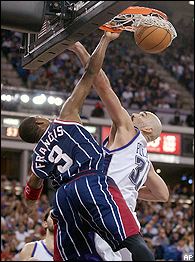This is the first in a four-part series of posts predicting playoff seedings for the upcoming year. Of course, predictions usually get made before the season starts, and these predictions are being posted after all teams have already played a few games. Why? Because I don’t watch preseason games. It doesn’t tell me enough about the teams playing to be worth my time. (If someone wants to pay me to write this blog, I’ll be happy to watch preseason games. Until then, I ain’t watchin’ no preseason game.) I’m not saying that the first 3 or 4 games tell me much of anything about a team, but it can’t hurt to get at least some data about how a team is actually playing.
I begin my analysis by looking at individual players; specifically, stars. For a team to make the playoffs, it obviously must have balance, depth, and role players. No question. But, in general, it also must have at least 1 star.
I don’t see more than 1 or 2 NBA teams making the playoffs that do not have an All-Star on their roster. I understand that Utah, Chicago, and Philadelphia made the playoffs last year even though they had no All-Stars, but, as a general rule, I think teams need to have All-Stars to make the playoffs. So, when attempting to pick the playoff teams, I think it makes sense to start by trying to pick the All-Stars.
A useful starting point is last year’s All-Star rosters:
EAST
Allen Iverson (Detroit)
Dwyane Wade (Miami)
LeBron James (Cleveland)
Kevin Garnett (Boston)
Dwight Howard (Orlando)
Joe Johnson (Atlanta)
Jameer Nelson (Orlando – injured)
Ray Allen (Boston)
Danny Granger (Indiana)
Paul Pierce (Boston)
Chris Bosh (Toronto)
Mo Williams (Cleveland)
Scot Pollard (Boston)
Just kidding. Scot Pollard was not an All-Star. I was just looking for an excuse to link to some pictures of Scot Pollard. Like this one:

And this one:

And, oh, most certainly, this one:

Devin Harris (New Jersey)
WEST
Kobe Bryant (LA Lakers)
Chris Paul (New Orleans)
Tim Duncan (San Antonio)
Amare Stoudemire (Phoenix)
Yao Ming (Houston)
Dirk Nowitzki (Dallas)
Shaquille O’Neal (Phoenix)
Brandon Roy (Portland)
Chauncey Billups (Denver)
Pau Gasol (LA Lakers)
David West (New Orleans)
Tony Parker (San Antonio)
I expect this year’s All-Star rosters to be very much the same as last year’s, with a few changes. I see Derrick Rose making the All-Star team in the East, and probably Gilbert Arenas and Elton Brand, as well, assuming they are healthy. If that’s right, the roster will be:
Derrick Rose (Chicago)
Dwyane Wade (Miami)
LeBron James (Cleveland)
Kevin Garnett (Boston)
Dwight Howard (Orlando)
Joe Johnson (Atlanta)
Gilbert Arenas (Washington)
Ray Allen (Boston)
Danny Granger (Indiana)
Paul Pierce (Boston)
Chris Bosh (Toronto)
Elton Brand (Philadelphia)
Next 3: Devin Harris, Michael Redd, Hedo Turkoglu
Sleepers: Raymond Felton, Jermaine O’Neal
The Western Conference All-Star team will also be very much the same as last year’s, with a few changes. Shaq has moved to the East, and Yao is out. I expect Carmelo Anthony to make the All-Star team, and expect Kevin to make a run at it (Blake Griffin, too, if he returns soon). I also expect Derron Williams to make the team, and, if Tracy McGrady is healthy, he needs to be considered as well. I will believe that McGrady is back to 100% when I see it, so I’m predicting this All-Star roster:
Kobe Bryant (LA Lakers)
Chris Paul (New Orleans)
Tim Duncan (San Antonio)
Amare Stoudemire (Phoenix)
Dirk Nowitzki (Dallas)
LaMarcus Aldridge (Portland)
Kevin Durant (OK City)
Brandon Roy (Portland)
Carmelo Anthony (Denver)
Pau Gasol (LA Lakers)
David West (New Orleans)
Derron Williams (Utah)
Next 3: Tony Parker, Al Jefferson, Chauncey Billups
Sleepers: Jeff Green, Jason Kidd, Marcus Camby
Part 2 of my 4 part series predicting the playoff teams will be posted tomorrow.

I found your blog on google and read a few of your other posts. I just added you to my Google News Reader. Keep up the good work Look forward to reading more from you in the future.